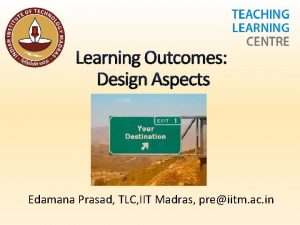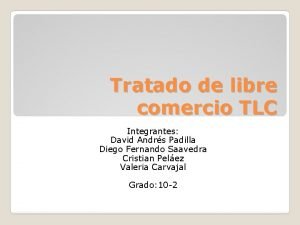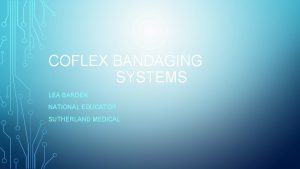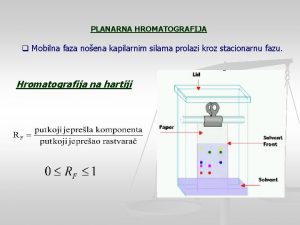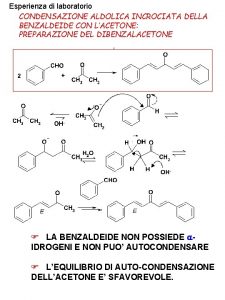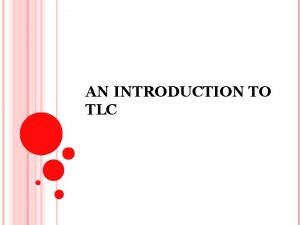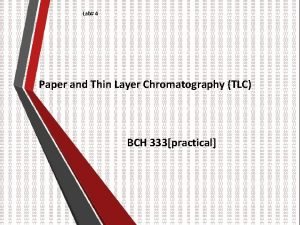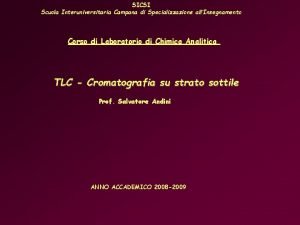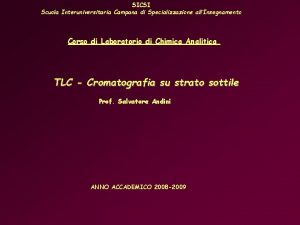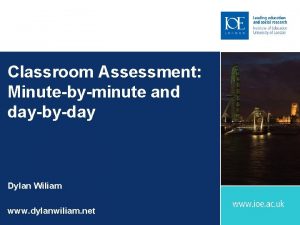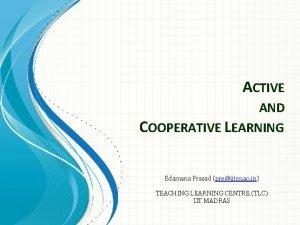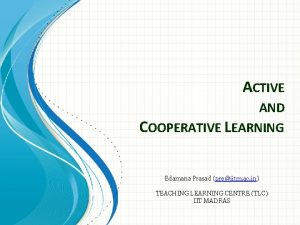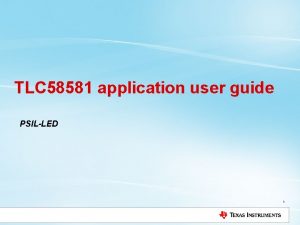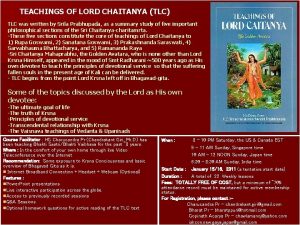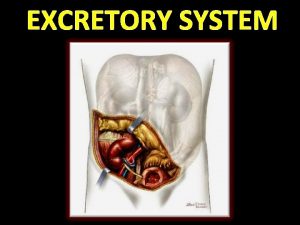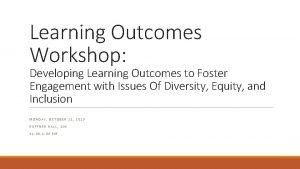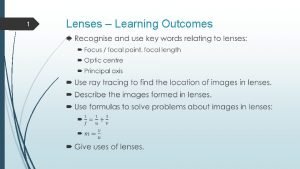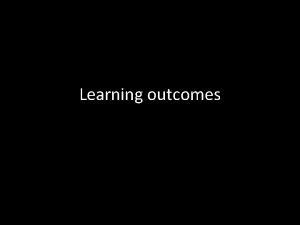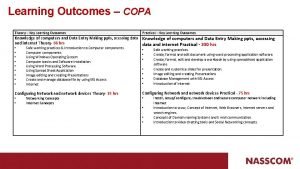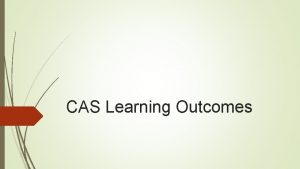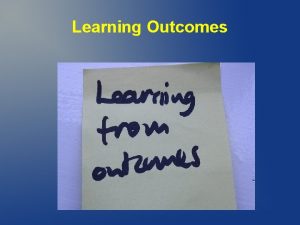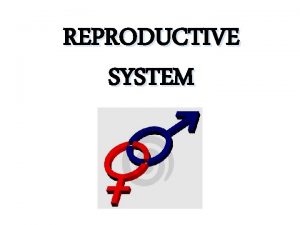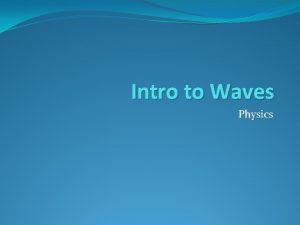Learning Outcomes Design Aspects Edamana Prasad TLC IIT






























- Slides: 30

Learning Outcomes: Design Aspects Edamana Prasad, TLC, IIT Madras, pre@iitm. ac. in

Thanks to. . Dr Jeffrey E. Froyd

What do you expect your students to learn in your course? Think about the question Share your thoughts in your group Activity time: 03 minutes

Learning Outcome of this session. . At the end of the session, you will be able to Write Learning Outcome for your course

Learning Outcomes (LO) LO should address the following questions: q What should your learner DO as a result of your instruction? OR q In what level should your learner think as a result of your instruction?

What should be the purpose of learning outcomes? instructor’s point of view) (From the instructor Think about the question Share your thoughts in your group Activity time: 03 minutes

Responses

Purpose Outcomes help instructors To make guidelines for preparing classroom material To keep the focus on specific end results To create homework assignments To design exams questions

What should be the purpose of learning outcomes? learner’s point of view) (From the learner Think about the question Share your thoughts in your group Activity time: 03 minutes

Responses

Purpose Outcomes help students To get a clear course goal To get a framework for measuring their success by themselves To reduce their stress To improve their studying effectiveness Source - http: //ublib. buffalo. edu/libraries/projects/tlr/importance. html

Defining learning outcome Learning outcome is your expectation of the learner performance in a course Learning Outcome should contain a observable/measurable action verb The action verb should describe the expected performance from the learner

Exercise: Writing Learning Outcome Think about a course you will be teaching in next semester Write a learning outcome for the course Activity time: 05 minutes

Challenges Most of us tend to use verbs such as Ø Understand Ø Know Ø Appreciate Ø Demonstrate knowledge…. Etc. Ø What is the problem?

Certain action verbs do not convey the intended meaning Assume that the learning outcome is: The student will be able to understand first law of thermodynamics. To check learning, the teacher may frame the following questions: a. State first law of thermodynamics b. Use first law of thermodynamics to solve the problem c. Judge whether the following system obey first law of thermodynamics Do they require same Cognitive Effort?

Choosing the right Action Verb A helpful tool – Bloom’s Taxonomy Devised by Benjamin Bloom and colleagues in 1950 s Focus on 3 domains Cognitive (Thinking) Affective (Attitudes/ Feeling) Psychomotor (doing) Bloom, B. S. & David R. K. (1956). Taxonomy of Educational Outcomes Handbook 1: Cognitive domain. New York , Longmans.

Original Taxonomy Different levels of learning/thinking Knowledge Analysis Seeing patterns Synthesis Create new ideas Recall of Information mastery of subject matter recognition of nuances from existing ones Comprehension Evaluation Application Understanding meaning getting the context Compare ideas assess value Solving problems using given information Can you arrange these from ‘less challenging’ to ‘more challenging’ order?

Taxonomy and Levels of Thinking Evaluation Synthesis Higher levels of thinking Analysis Application Comprehension Lower levels of thinking Knowledge How are these helpful in writing learning outcomes?

Bloom’s Taxonomy The verbs involved in the levels are more evident Synthesis is moved to the highest level of thinking Evaluation Create Synthesis Evaluate Analysis Analyze Application Apply Comprehension Understand Knowledge Remember Original Revised Anderson, L. W. et al (2001). A Taxonomy for teaching, learning, and assessing: A revision of Bloom’s Taxonomy of Educational Objectives. New York , Longman.

Exercise: Writing LO using Blooms Taxonomy Think of a course you will be teaching next semester Write two learning outcomes for this course with different cognitive challenge, using Bloom’s taxonomy Activity time: 05 minutes

BLOOM’S REVISED TAXONOMY Create Generating new ideas, products, or ways of viewing things Design, construct, plan, produce, invent. Evaluate Justifying a decision or course of action Check, hypothesise, critique, experiment, judge Analyse Breaking information into parts to explore understandings and relationships Compare, organise, deconstruct, interrogate, find Apply Using information in another familiar situation Implement, carry out, use, Understand execute Explaining ideas or concepts Interpret, summarise, paraphrase, classify, Remember explain Recalling information Recognize, list, describe, retrieve, name, find

Learning Outcomes & Bloom’s Taxonomy A two step approach to learning outcomes Step 1 : Identify the levels of thinking involved in the course using Bloom’s Taxonomy Do you want the students to……. Remember the material taught? Understand it? Apply it? Analyze it? Evaluate it? Create something new from it? http: //cte. illinois. edu/resources/topics/syllabus/objective. html

Step Two Choose the right verb for that level Creating – construct, design, generate, plan, produce Evaluating – critique, justify, conclude, judge, hypothesize Analyzing – correlate, distinguish, deconstruct Applying – determine, develop, compute, utilize, implement Understanding – classify, explain, discuss, give example, summarize Remembering – define, describe, list, reproduce, identify http: //www. niu. edu/facdev/programs/handouts/blooms. shtml

What are your questions on LO?

Individual Activity Identify levels of Bloom’s Taxonomy for the following LOs? Activity Time – 2 minutes Learning Outcome 1 2. Identify the system which shows apparent violation to third law of thermodynamics Identify the reason for apparent violation to third law of thermodynamics Creating Evaluating Analyzing Applying Understanding Remembering

Pair Exercise Write a set of criteria by which you would evaluate a set of learning outcomes Pair with a colleague Prepare your criteria 10 minutes

Pair Exercise ? ?

Pair Exercise Review and revise your set of learning outcomes based on criteria developed Pair with a colleague Give each other feedback on your learning outcomes 10 minutes Remaining questions?

Summary Your expectations should be explicit Learning outcomes make expectations explicit as well as establish a means to assess Learning outcomes explains the cognitive challenges in a course Learning outcomes provides a guideline for assessment Your teaching approaches change after you start incorporating learning outcomes

Minute Paper Write brief answers to the following questions: What is most valuable or helpful about writing learning outcomes? What is the “muddiest or most confusing point” about writing learning outcomes?
 Edamana prasad iitm
Edamana prasad iitm Tlc integrantes
Tlc integrantes Tlc project
Tlc project Hplc chromatography uses
Hplc chromatography uses Coflex tlc calamine lite 2 layer compression kit
Coflex tlc calamine lite 2 layer compression kit Tlc survey
Tlc survey Stacionarna faza
Stacionarna faza Sintesi del dibenzalacetone
Sintesi del dibenzalacetone Tlc introduction
Tlc introduction Paper chromatography
Paper chromatography Tlc
Tlc Tlc normal range
Tlc normal range Advantages of paper chromatography
Advantages of paper chromatography Tlc ui
Tlc ui Gbs controller
Gbs controller Sicsi
Sicsi Tlc dylan wiliam
Tlc dylan wiliam Thoma pipette wbc
Thoma pipette wbc Tlc pediatrics flint
Tlc pediatrics flint Serie eluotropa
Serie eluotropa Robotica tlc
Robotica tlc Tlc dylan wiliam
Tlc dylan wiliam Learning outcomes examples english
Learning outcomes examples english Learning outcomes of water cycle
Learning outcomes of water cycle Lesson plan on notice writing
Lesson plan on notice writing Swot analysis objectives
Swot analysis objectives Rhymes with understand
Rhymes with understand Example of learning objectives
Example of learning objectives Photosynthesis chlorophyll
Photosynthesis chlorophyll Learning outcomes of nutrition in plants
Learning outcomes of nutrition in plants Domain 6 community linkages explanation
Domain 6 community linkages explanation
